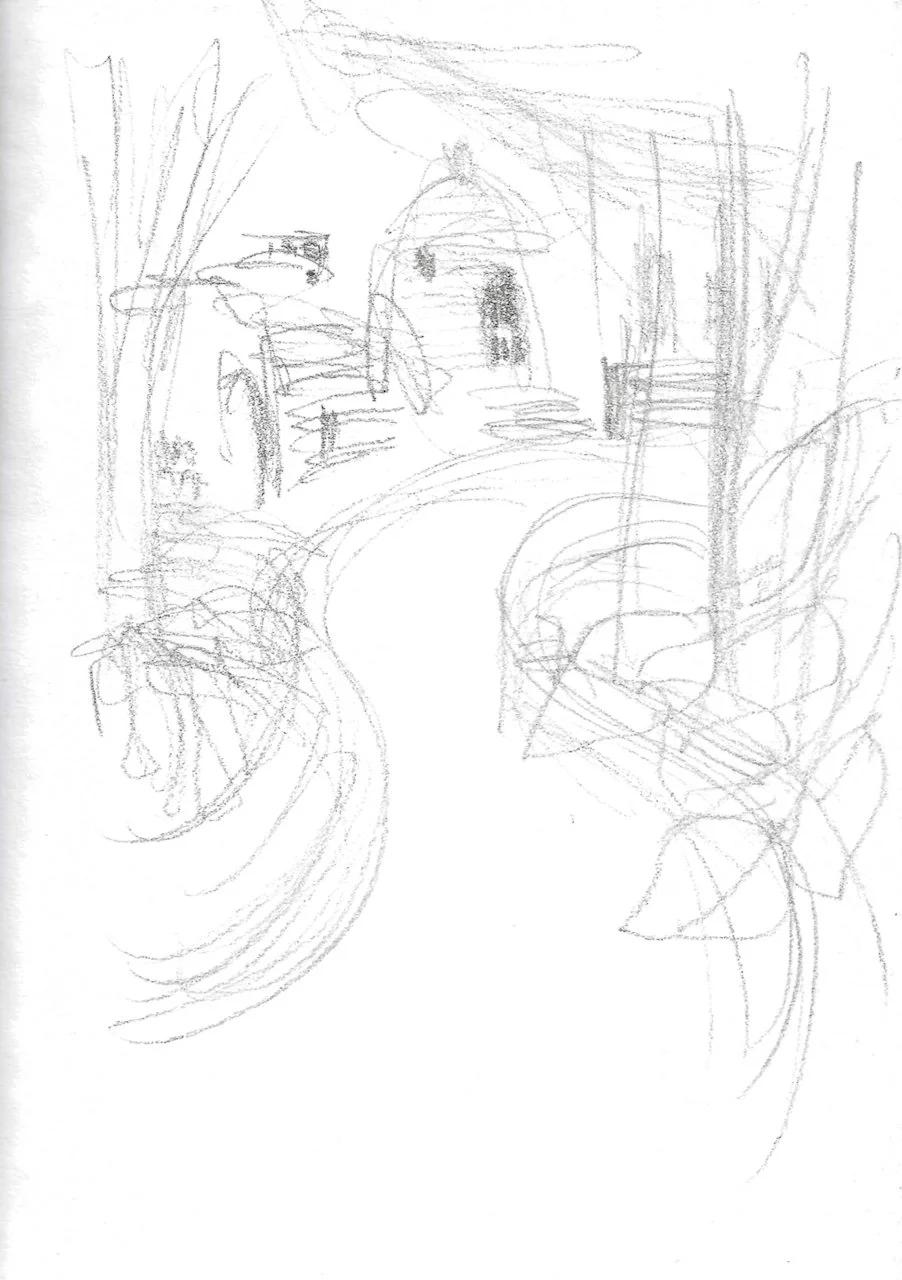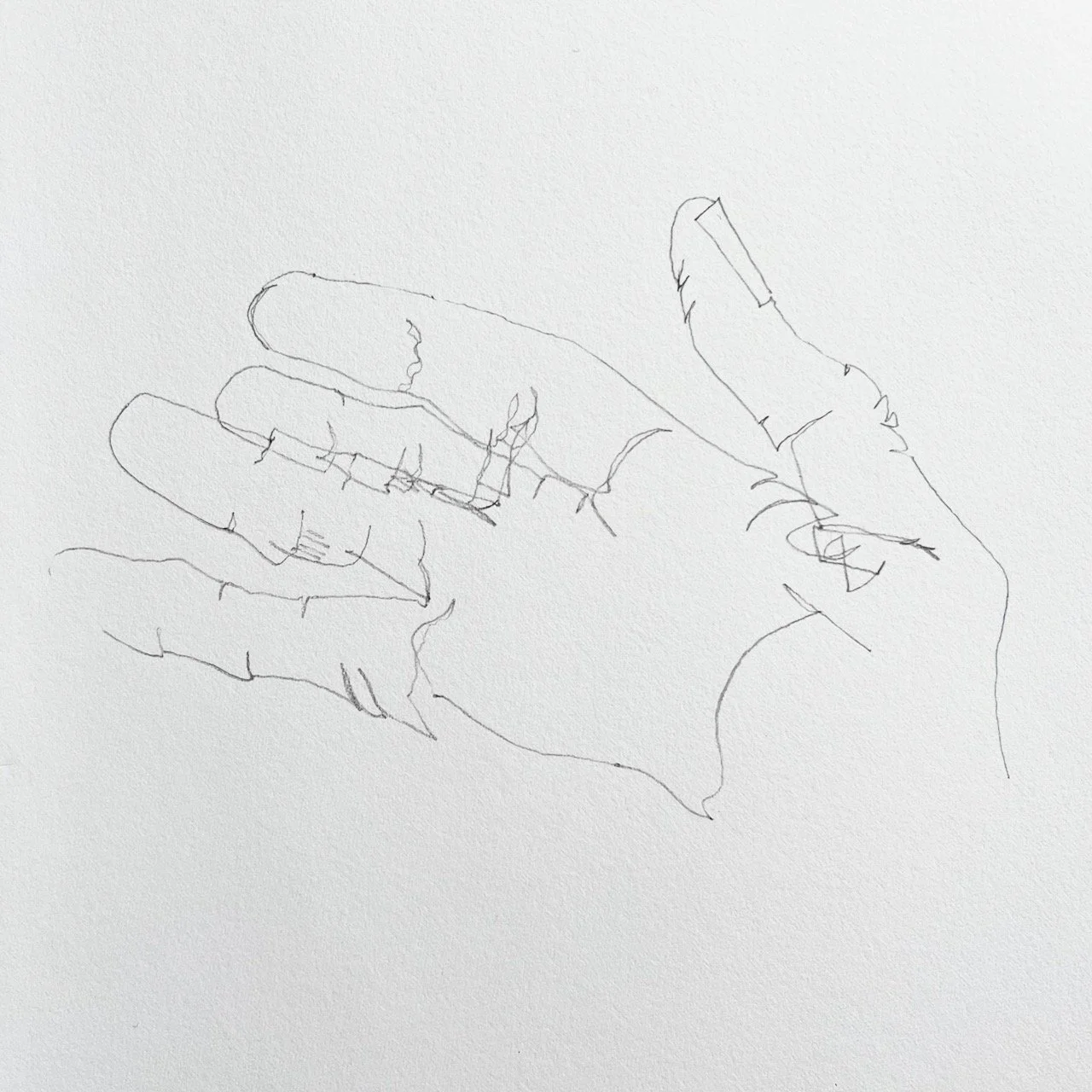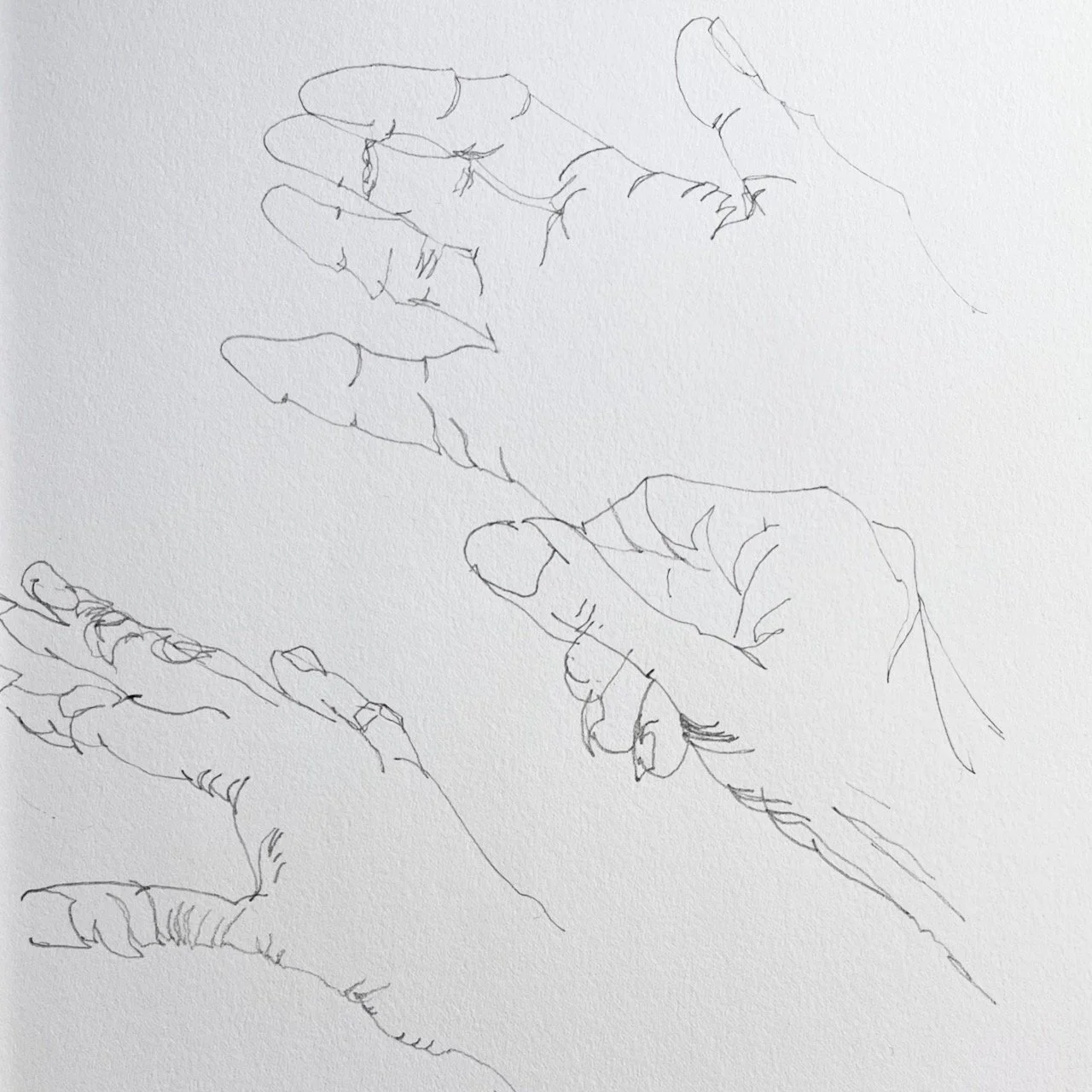The hand knows what the eye sees
During my residency at Plas Brondanw, I went out one day without my reading glasses and found that drawing without them freed up my drawing. I learnt later that, after a fashion, ‘drawing blind’ is quite the done thing.
I wear +2.00 magnification glasses when I’m reading and drawing, and double them up when engraving. Without my glasses I see anything that is close up through a haze. To realise then that I’d left my glasses behind that day was one of those oh-shit moments. Bugger — and then bugger it… I walked on and drew.
The Lookout, Garreg — a mid twentieth century folly designed by Clough Williams-Ellis.
Graphite in 10.5 x 14.5 cm sketchbook
The Lookout sits on a sweeping bend at the northern end of a run of seven late nineteenth century terrace houses as you approach Garreg from Beddgelert, and as I looked down at my drawing (through my glassless haze) I felt that I had captured something of the feeling of the place — the movement of the road, the perilous location of the houses, the way that the trees crowd over everything. Had I been wearing my glasses, I would have drawn the tower more ‘realistically’ (a phrase that comes with innumerable caveats), but most likely lacking in vitality. I spent the afternoon making drawings like this and since then, when I am outside I draw either exclusively without my glasses, or without them in the beginning. My eyes see, and my hand feels what my eyes see, and keeping my eyes on what I am looking at I see it better and draw better.
A couple of weeks ago, I took this approach a step further. Sitting in firelight, listening eyes closed to Ólafur Arnalds’ Momentary - choir version, I wondered what it might be like to draw, eyes closed, the things that I ‘see’ in my head. Might I draw more fluidly that way? I took two A3 sheets of cartridge paper and taped them to a board, put Momentary on loop, and stood at the easel with my right hand at the top so that I could orientate myself to the paper, a small stick of charcoal in my left. Eyes closed, I listened, conjuring moments into my head. And then I drew.
Two figures
Blind charcoal drawing, 42 x 60 cm, cartridge paper
I felt more than saw. Something vague — the bubble of an image in my head. Something that I couldn’t really nail down. There was the music. And the music made my hand move, pulling the flat side of the charcoal onto the paper to call up first the sun, then waves in the sea, an island, light sweeping over one, two figures sat on the beach watching the sun go down. With the charcoal, my arm outstretched, my eyes closed, I was literally touching what I was trying to draw. When I opened my eyes at the end, I was pleasantly surprised by what I had drawn.
Inspired, I googled ‘drawing eyes closed’ and read up on ideas related to what I’d done.
Artists will, I imagine, have always had a go at drawing ‘blind’. I mean, why not? Kimon Nikolaides, however, is credited with developing ‘blind’ drawing as a practice. In his book The Natural Way to Draw, he details a specific exercise for training people in how to see what they are drawing, arguing that ‘Learning to draw is really a matter of learning to see’. And his idea of seeing involves not only seeing through the eyes, but through all five senses and in particular through the sense of touch.
‘Contour drawing’, as he describes it, involves focusing on the contour of what you are drawing (as distinct from the outline) and imagining that your pencil is physically touching that contour. When you are convinced that it is actually touching the contour, you follow it with your ‘touch’, feeling more than seeing and you draw. Critically, you don’t look at your drawing unless the contour leaves the edge of what you are drawing and turns inward. If it does, you place your pencil on a new starting point and follow the contour again — regardless of whether this contour is on the edge of the subject or inside it. Drawing like this should, he states, be done ‘slowly, searchingly, sensitively.’
Betty Edwards drew on Nikolaides’ exercise in her book Drawing on the Right Side of the Brain. She calls her version ‘pure contour drawing’ and it differs from Nikolaides in that looking at the drawing is prohibited throughout the entire act of drawing.
In Edwards’ exercise, you sit side on to the subject of your drawing. She suggests using your hand as your first subject. You look at the hand that you are drawing, your paper at a right angle to it, out of your sight, and you draw the palm of your hand, following first one crease and then the next and so on for five minutes, and all the time looking solely at your hand and never at your drawing. The idea here is not to produce a ‘good’ drawing, but rather to train the brain to see in a different way, shutting out what see calls the L-mode of the brain, and allowing the R-mode full rein — the R-mode being more associated with the ability to draw.
Neither contour drawing nor pure contour drawing were quite what I had done that evening, but they sounded interesting so, I had a go — first at Edwards’ pure content drawing and then Nikolaides’ contour drawing.
I confess that I struggled a bit with the pure contour drawing — not so much because it didn’t produce a ‘good’ drawing (in its way, the marks are interesting), but more because I was unsure when to follow one crease, one line, rather than another. Perhaps I had not fully left the L-mode behind; I was making decisions rather than just looking. In contrast, I found Nikolaides’ exercise rewarding. The hands I drew are demonstrably my hand and yet not my hand. I like the fractured quality of them — the slippage, for example in Contour drawing 1, between hand and wrist, and between one phalange and the next phalange in each finger. This fracturing of the hand seems to capture something of the movement of which a hand is capable. In contrast, the drawings below are ones that I did a couple of years back whilst looking both at my hand and at my drawing. They are ‘better’ drawings, nor ‘worse’ drawings; simply different.
Studies of a hand
15.5 x 20.5 cm, graphite, Fabriano Classic Artist’s Journal
References:
Betty Edwards, Drawing on the Right Side of the Brain (4th ed.), 2012.
Kimon Nikolaides, The Natural Way To Draw: A Working Plan For Art Study, 1941.






